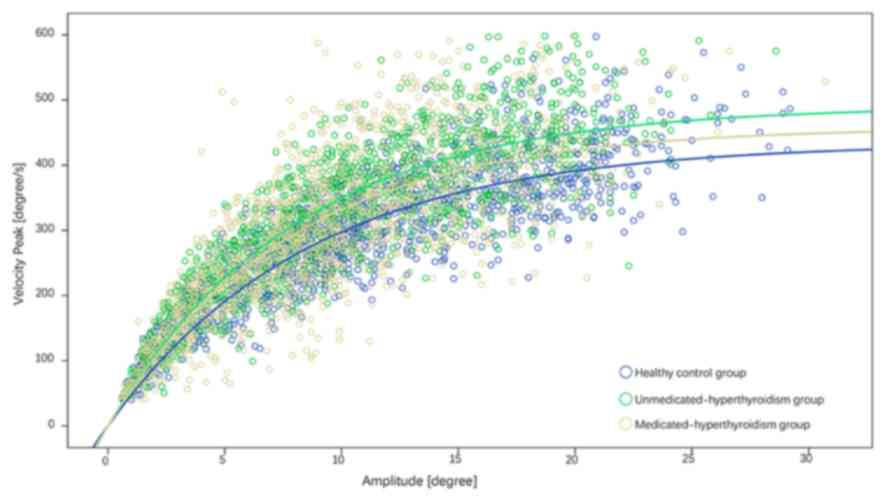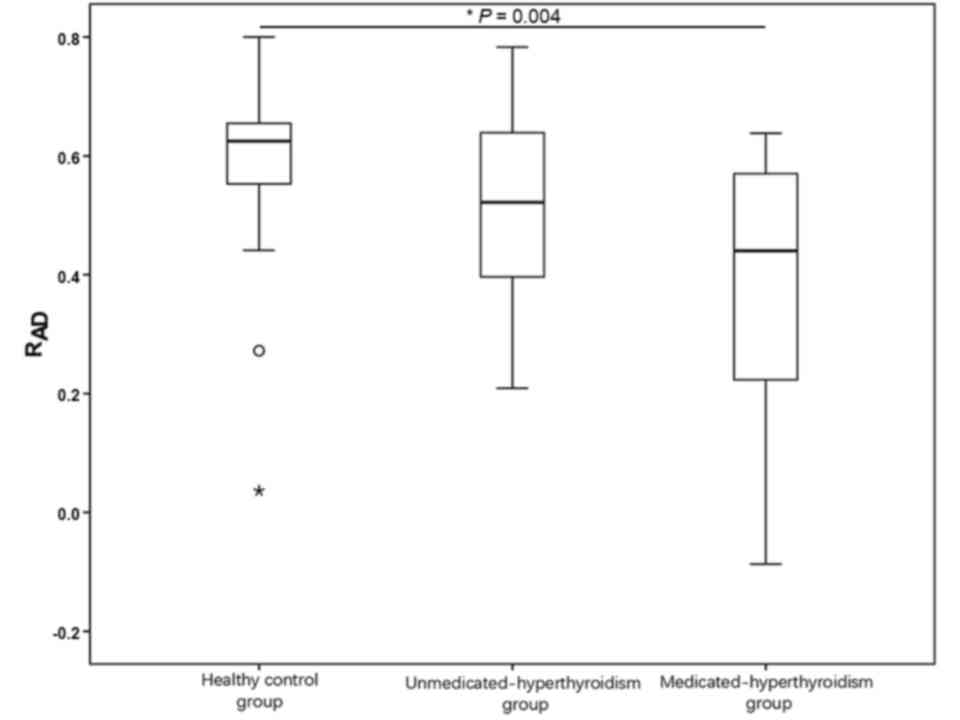|
1
|
Joffe B, Gunji K, Panz V, Zouvanis M,
Swanson J, Ackrell BA and Wall JR: Thyroid-associated
ophthalmopathy in black South African patients with Graves'
disease: Relationship to antiflavoprotein antibodies. Thyroid.
8:1023–1027. 1998. View Article : Google Scholar : PubMed/NCBI
|
|
2
|
Prummel MF, Wiersinga WM, Mourits MP,
Koornneef L, Berghout A and van der Gaag R: Effect of abnormal
thyroid function on the severity of Graves' ophthalmopathy. Arch
Intern Med. 150:1098–1101. 1990. View Article : Google Scholar : PubMed/NCBI
|
|
3
|
Brent GA: Clinical practice. Graves'
disease. N Engl J Med. 358:2594–2605. 2008. View Article : Google Scholar : PubMed/NCBI
|
|
4
|
Teissier MP and Lopez S:
Thyroid-associated ophthalmopathy: Physiopathology, endocrine
status. J Fr Ophtalmol. 27:806–809. 2004.(In French). View Article : Google Scholar : PubMed/NCBI
|
|
5
|
Kahaly GJ, Hardt J, Petrak F and Egle UT:
Psychosocial factors in subjects with thyroid-associated
ophthalmopathy. Thyroid. 12:237–239. 2002. View Article : Google Scholar : PubMed/NCBI
|
|
6
|
Hart RH, Kendall-Taylor P, Crombie A and
Perros P: Early response to intravenous glucocorticoids for severe
thyroid-associated ophthalmopathy predicts treatment outcome. J
Ocul Pharmacol Ther. 21:328–336. 2005. View Article : Google Scholar : PubMed/NCBI
|
|
7
|
Wiersinga WM: Management of Graves'
ophthalmopathy. Nat Clin Pract Endocrinol M. 3:396–404. 2007.
View Article : Google Scholar
|
|
8
|
Rajabi MT, Papageorgiou K, Taban M, Hwang
CJ, Hosseini SS, Rajabi MB and Goldberg RA: Ultrasonographic motion
analysis of lower eyelid compartments in patients with chronic
thyroid associated ophthalmopathy. J Curr Ophthalmol. 29:310–317.
2017. View Article : Google Scholar : PubMed/NCBI
|
|
9
|
Fang ZJ, Zhang JY and He WM: CT features
of exophthalmos in Chinese subjects with thyroid-associated
ophthalmopathy. Int J Ophthalmol. 6:146–149. 2013.PubMed/NCBI
|
|
10
|
Shen J, Jiang W, Luo Y, Cai Q, Li Z, Chen
Z, Hu S and Tang L: Establishment of magnetic resonance imaging 3D
reconstruction technology of orbital soft tissue and its
preliminary application in patients with thyroid-associated
ophthalmopathy. Clin Endorinol (oxf). 88:637–644. 2018. View Article : Google Scholar
|
|
11
|
Stan MN, Garrity JA and Bahn RS: The
evaluation and treatment of graves ophthalmopathy. Med Clin North
Am. 96:311–328. 2012. View Article : Google Scholar : PubMed/NCBI
|
|
12
|
Gould DJ, Roth FS and Soparkar CN: The
diagnosis and treatment of thyroid-associated ophthalmopathy.
Aesthetic Plast Surg. 36:638–648. 2012. View Article : Google Scholar : PubMed/NCBI
|
|
13
|
McDowell JE, Dyckman KA, Austin BP and
Clementz BA: Neurophysiology and neuroanatomy of reflexive and
volitional saccades: evidence from studies of humans. Brain Cogn.
68:255–270. 2008. View Article : Google Scholar : PubMed/NCBI
|
|
14
|
Feldon SE and Unsöld R: Graves'
ophthalmopathy evaluated by infrared eye-movement recordings. Arch
Ophtalmol. 100:324–328. 1982. View Article : Google Scholar
|
|
15
|
Feldon SE, Levin L and Liu SK: Graves'
ophthalmopathy. Correlation of saccadic eye movements with age,
presence of optic neuropathy and extra ocular muscle volume. Arch
Ophthalmol. 108:1568–1571. 1990. View Article : Google Scholar : PubMed/NCBI
|
|
16
|
Schworm HD, Bolzani R, Benassi M,
Tallstedt L, Rydberg A, Lennerstrand G and Ygge J: Changes of
saccadic eye movements in thyroid-associated ophthalmopathy. Acta
Ophthalmol. 90:713–720. 2012. View Article : Google Scholar : PubMed/NCBI
|
|
17
|
Schworm HD, Heufelder AE, Kunze A, Welge E
and Boergen KP: Clinical significance of saccade analysis in early
active Graves' ophthalmopathy. Invest Ophthalmol Vis Sci.
41:1710–1718. 2000.PubMed/NCBI
|
|
18
|
Sun Y, Kong X, Wang C, Xu Y, Wang K and
Zhu D: Abnormalities in saccade dynamics in first-episode
treatment-naive hyperthyreosis patients with no pre-existing eye
damage: A primary exploratory study. Int J ClinExp Med.
9:11626–11632. 2016.
|
|
19
|
Van Dyk HJ: Orbital Graves' disease. A
modification of the ‘NO SPECS’ classification. Ophthalmology.
88:479–483. 1981. View Article : Google Scholar : PubMed/NCBI
|
|
20
|
Dolman PJ: Evaluating Graves' orbitopathy.
Best Pract Res Clin Endocrinol Metab. 26:229–248. 2012. View Article : Google Scholar : PubMed/NCBI
|
|
21
|
Cui H, Liu XH, Wang KY, Zhu CY, Wang C and
Xie XH: Association of saccade duration and saccade
acceleration/deceleration asymmetry during visually guided saccade
in schizophrenia patients. PLoS One. 9:e973082014. View Article : Google Scholar : PubMed/NCBI
|
|
22
|
Ferhat O and Vilariño F: Low cost eye
tracking: The current panorama. Comput Intell Neurosci.
2016:86805412016. View Article : Google Scholar : PubMed/NCBI
|
|
23
|
Guo S, Pan S, Shi L, Guo P, He Y and Tang
K: Visual detection and tracking system for a spherical amphibious
robot. Sensors (Basel). 17(pii): E8702017. View Article : Google Scholar : PubMed/NCBI
|
|
24
|
Asan O and Yang Y: Using eye trackers for
usability evaluation of health information technology: A systematic
literature review. JMIR Hum Factors. 2:e52015. View Article : Google Scholar : PubMed/NCBI
|
|
25
|
Srivastava A, Sharma R, Sood SK, Shukla G,
Goyal V and Behari M: Saccadic eye movements in Parkinson's
disease. Indian J Ophthalmol. 62:538–544. 2014. View Article : Google Scholar : PubMed/NCBI
|
|
26
|
Turner TH, Goldstein J, Hamilton JM,
Jacobson M, Pirogovsky E, Peavy G and Corey-Bloom J: Behavioral
measures of saccade latency and inhibition in manifest and
premanifest Huntington's disease. J Mot Behav. 43:295–302. 2011.
View Article : Google Scholar : PubMed/NCBI
|
|
27
|
Vinny PW and Lal V: Gaze disorders: A
clinical approach. Neurol India. 64:121–128. 2016. View Article : Google Scholar : PubMed/NCBI
|
|
28
|
MacAskill MR and Anderson TJ: Eye
movements in neurodegenerative diseases. Curr Opin Neurol.
29:61–68. 2016. View Article : Google Scholar : PubMed/NCBI
|
|
29
|
Fernández G, Manes F, Politi LE, Orozco D,
Schumacher M, Castro L, Agamennoni O and Rotstein NP: Patients with
mild Alzheimer's disease fail when using their working memory:
Evidence from the eyetracking technique. J Alzheimers Dis.
50:827–838. 2016. View Article : Google Scholar : PubMed/NCBI
|
|
30
|
Termsarasab P, Thammongkolchai T, Rucker
JC and Frucht SJ: The diagnostic value of saccades in movement
disorder patients: A practical guide and review. J Clin Mov Disord.
2:142015. View Article : Google Scholar : PubMed/NCBI
|
|
31
|
Wang L and Ma JM: Progression of the
pathogenesis of thyroid associated ophthalmopathy. Zhonghua Yan Ke
Za Zhi. 53:474–480. 2017.(In Chinese). PubMed/NCBI
|
|
32
|
Madaschi S, Rossini A, Formenti I,
Lampasona V, Marzoli SB, Cammarata G, Politi LS, Martinelli V,
Bazzigaluppi E, Scavini M, et al: Treatment of thyroid-associated
orbitopathy with rituximab-a novel therapy for an old disease: Case
report and literature review. Endocr Pract. 16:677–685. 2010.
View Article : Google Scholar : PubMed/NCBI
|
|
33
|
Savku E and Gündüz K: Diagnosis, follow-up
and treatment results in thyroid ophthalmopathy. Turk J Ophthalmol.
45:156–163. 2015. View Article : Google Scholar : PubMed/NCBI
|
|
34
|
Bartalena L, Marcocci C and Pinchera A:
Treating severe Graves' ophthalmopathy. Baillieres Clin Endocrinol
Metab. 11:521–536. 1997. View Article : Google Scholar : PubMed/NCBI
|
|
35
|
Tani J, Gopinath B, Nguyen B and Wall JR:
Extraocular muscle autoimmunity and orbital fat inflammation in
thyroid-associated ophthalmopathy. Expert Rev Clin Immunol.
3:299–311. 2007. View Article : Google Scholar : PubMed/NCBI
|
|
36
|
Kommerell G, Olivier D and Theopold H:
Adaptive programming of phasic and toniccomponents in saccadic eye
movements. Investigations of patients with abducens palsy. Invest
Ophthalmol. 15:657–660. 1976.PubMed/NCBI
|
|
37
|
Inchingolo P, Accardo A, Da Pozzo S,
Pensiero S and Perissutti P: Cyclopean and disconjugate adaptive
recovery from post-saccadic drift in strabismic children before and
after surgery. Vision Res. 36:2897–2913. 1996. View Article : Google Scholar : PubMed/NCBI
|
|
38
|
De Leo S, Lee SY and Braverman LE:
Hyperthyroidism. Lancet. 388:906–918. 2016. View Article : Google Scholar : PubMed/NCBI
|
|
39
|
Straube A, Fuchs AF, Usher S and Robinson
FR: Characteristics of saccadic gain adaptationin rhesus macaques.
J Neurophysiol. 77:874–895. 1997. View Article : Google Scholar : PubMed/NCBI
|
|
40
|
Baloh RW, Sills AW, Kumley WE and Honrubia
V: Quantitative measurement of saccade amplitude, duration, and
velocity. Neurology. 25:1065–1070. 1975. View Article : Google Scholar : PubMed/NCBI
|
|
41
|
Xie Xinhui, Liu Xiaohui, Wang Chen, Zhu
Chunyan, Cui Hong and Wang Keyong: Lower correlation between
saccade velocity asymmetry and amplitude during visually guided
saccade in schizophrenia patients. Chin J Psychiatry. 47:276–280.
2014.
|
|
42
|
Rundle FF: Eye signs of Graves' disease.
Thyroid. 171–197. 1964.
|
|
43
|
Naik V, Khadavi N, Naik MN, Hwang C,
Goldberg RA, Tsirbas A, Smith TJ and Douglas RS: Biologic
therapeutics in thyroid-associated ophthalmopathy: Translating
disease mechanism into therapy. Thyroid. 18:967–971. 2008.
View Article : Google Scholar : PubMed/NCBI
|
|
44
|
Kaspar M, Archibald C, De BA, Li AW,
Yamada M, Chang CH, Kahaly G and Wall JR: Eye muscle antibodies and
subtype of thyroid-associated ophthalmopathy. Thyroid. 12:187–191.
2002. View Article : Google Scholar : PubMed/NCBI
|
|
45
|
Bahn RS: Graves' ophthalmopathy. N Engl J
Med. 362:726–738. 2010. View Article : Google Scholar : PubMed/NCBI
|
















